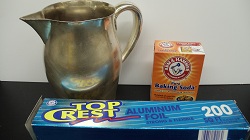![]()
Electrochemistry
19.4 Cleaning Tarnished Silver
 Subjects: Electrochemistry, oxidation/reduction
Subjects: Electrochemistry, oxidation/reduction
Description: A piece of tarnished silver is cleaned using an aqueous solution of baking soda, salt and aluminum foil.
Materials:
- Piece of tarnished silver
- Aluminum foil, crumpled
- Baking soda (~1 tsp)
- Salt (~1 tsp)
- Container for holding solution and dipping silver item
- Hot plate
Procedure:
1. Heat the water.
2. Add the baking soda, salt, and aluminum foil to the water.
3. Dip the tarnished silver in the solution.
4. Once the silver is clean, rinse with water and dry.
Discussion:
When silver tarnishes, it combines with sulfur and forms silver sulfide (Ag2S). Silver sulfide is black. When a thin coating of silver sulfide forms on the surface of silver, it darkens the silver. The silver can be returned to its former luster by removing the silver sulfide coating from the surface.
There are two ways to remove the coating of silver sulfide. One way is to remove the silver sulfide from the surface using a polish, and rubbing the tarnish off to produce a luster. However, this method also removes some of the silver in the process. The other method is to reverse the chemical reaction and reduce silver sulfide back into silver. This method leaves the silver intact, and is the method used in this demonstration.
In the reaction, the silver sulfide reacts with the aluminum metal. Aluminum is oxidized to aluminum oxide (Al2O3) and the silver in silver sulfide is reduced back to silver metal. The reaction is given below:
OXIDATION: 2 Al(s) + 6 OH– (aq) –––> Al2O3(s) + 3 H2O (l) + 6 e–
REDUCTION: Ag2S(s) + 2 H2O (l) + 2 e– –––> 2 Ag(s) + H2S (aq) + 2 OH– (aq)
3 Ag2S(s) + 2 Al(s) + 3 H2O (l) –––> 6 Ag(s) + 3 H2S (aq) + Al2O3(s)
Hydrogen sulfide is also produced. The reaction goes faster when the solution is warm.
Safety: None
Disposal: Contents can go down the drain.
References:
1. SciFun website: http://scifun.chem.wisc.edu/homeexpts/tarnish.html
2. Prof. Botch


